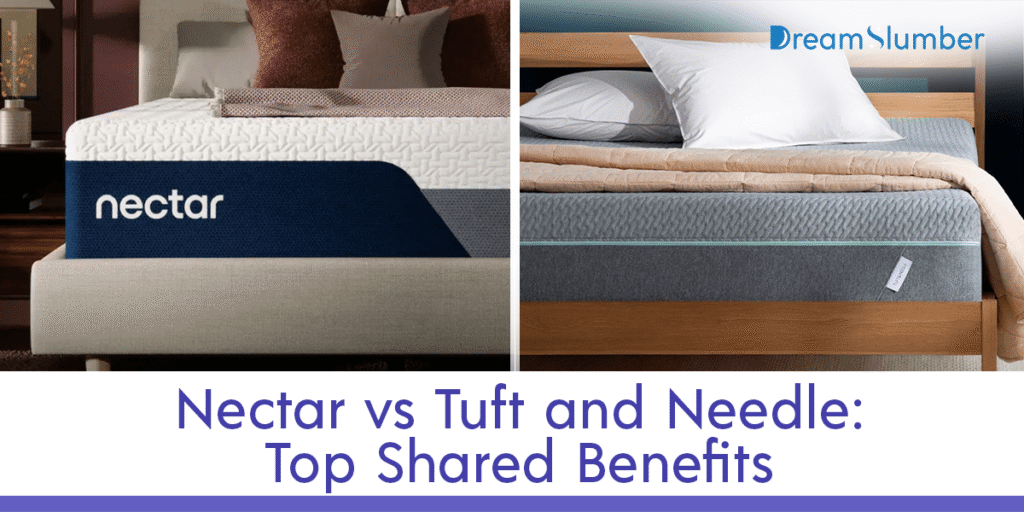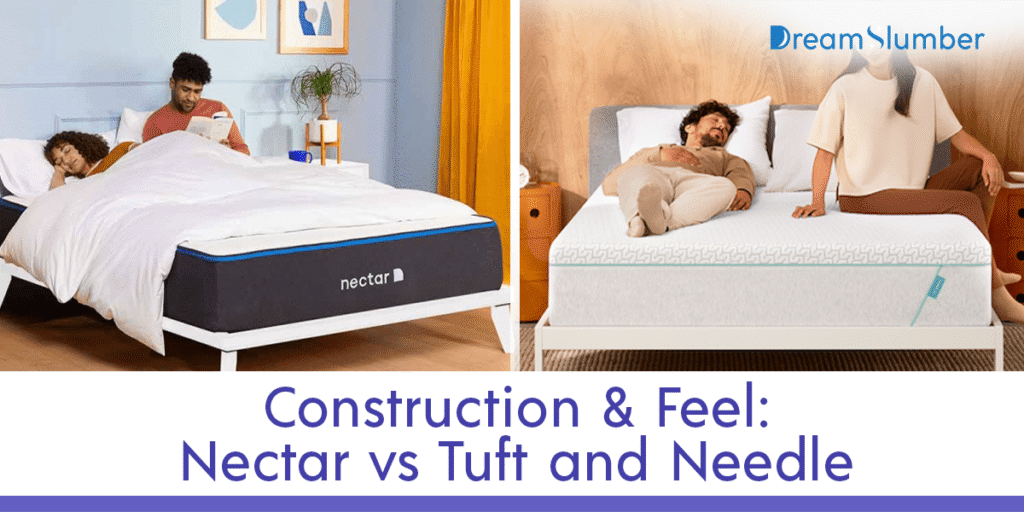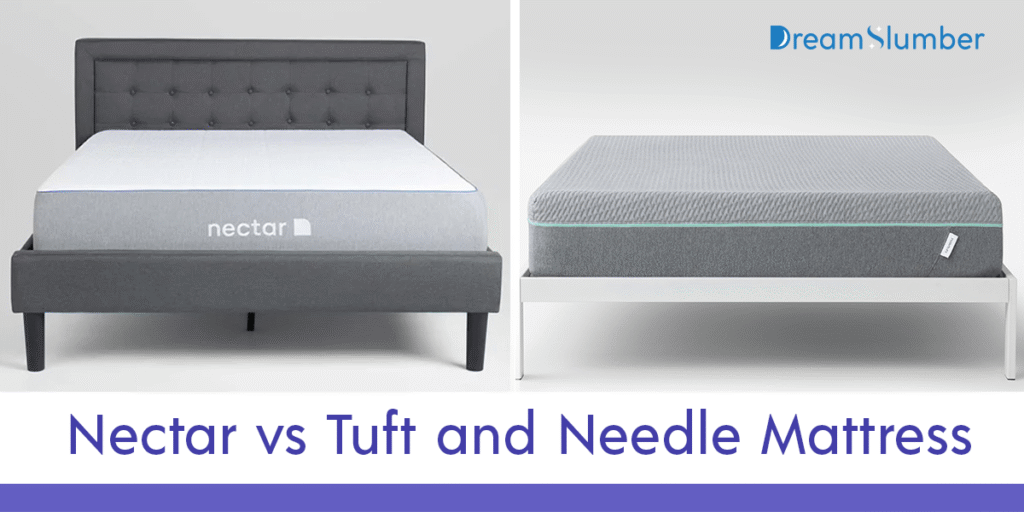When you purchase through our links, we may earn a commission at no extra cost to you. As an Amazon Associate, DreamSlumber earns from qualifying purchases. Learn more.
⭐ Quick Verdict: Nectar vs Tuft & Needle
Nectar Memory Foam is best if you want deep pressure relief, motion isolation, and long-term value with a 365-night trial + lifetime warranty.
Tuft & Needle Original is better if you prefer a responsive, temperature-neutral feel and easier movement with straightforward design and budget-friendly pricing.
- Best for Side Sleepers & Couples → Nectar
- Best for Combination/Stomach Sleepers → Tuft & Needle
- Best Long-Term Value → Nectar
Keep reading for detailed side-by-side specs, performance scores, and buyer insights.
Nectar vs Tuft and Needle is a common question for people choosing a foam bed. Both mattresses are well-known for their comfort, support, and value. They also arrive in a box and are easy to set up.
But which one is better for your sleep needs?
In this guide, we’ll break down every detail. We’ll look at materials, feel, support, and who each mattress suits best. If you deal with back pain or sleep hot, we’ve got answers. If you’re a side sleeper, a couple, or a budget shopper, we’ll cover that, too.
Our goal is to help you feel more confident in choosing the best mattress for your body and wellness. Let’s start with a side-by-side look at their main features.
Nectar vs Tuft and Needle: Core Specifications Compared
Choosing between Nectar and Tuft and Needle starts with understanding their core features. Both are all-foam mattresses. Both come packed in a box. And both promise a mix of comfort, support, and cooling.
However, upon closer examination, they serve different sleep needs. One feels softer. The other offers a bouncier feel and quicker response. One gives a long trial and warranty. Tuft and Needle focuses on simple, supportive comfort with certified non-toxic materials. For deeper insights into eco-conscious mattress certifications, compare leading organic brands.
Here’s a detailed side-by-side table comparing the Queen-size options for 2025:
| Feature | Nectar Classic 12” | Tuft and Needle Original 10” |
| Price Range (Queen) | Check Latest Price | Check Latest Price |
| Firmness | Medium-firm (6.5–7 out of 10) | Medium (6–6.5 out of 10) |
| Thickness | 12 inches | 10 inches |
| Sleep Trial | 365 nights (1 full year) | 100 nights |
| Warranty | Lifetime warranty (forever coverage) | 10-year limited warranty |
| Materials | Gel memory foam + dynamic support foam + breathable cover | Adaptive foam + gel + graphite + ventilated support |
| Best For | Side sleepers, couples, hot sleepers, and back pain relief | Combo sleepers, hot sleepers, stomach sleepers |
| Included Accessories | Bed-in-a-box + Forever warranty + fiberglass-free build | Bed-in-a-box + CertiPUR-US + GREENGUARD Gold certified |

Nectar vs Tuft and Needle: Top 3 Shared Benefits
Both Nectar and Tuft and Needle are popular for a reason. They offer great comfort, support, and value. If you’re looking for healthier sleep, these mattresses check many boxes.
Here are the top three features both brands share:
All-Foam Construction
Both mattresses skip the springs and use full-foam layers. That means no squeaky coils. You’ll feel less partner movement during the night. This makes them great motion isolation mattresses, especially for light sleepers or couples.
Cooling Technology
Memory foam usually traps heat. But both brands try to fix this. Nectar uses a cooling top layer that draws away body heat. Tuft and Needle blends graphite and cooling gel into their Adaptive foam. This combo helps wick heat away. Both options can be called temperature-regulating mattresses, ideal for warm nights or those with nighttime overheating issues. If you’re concerned about trapped heat, explore how specialized cooling foams combat warmth differently.
Pressure Relief
No one wants to wake up sore. That’s why both brands use pressure-relief foam layers. Nectar’s contouring memory foam gently cradles your hips and shoulders. Tuft and Needle’s responsive foam balances cushioning and bounce. These features help reduce stress on joints and muscles, making them great spine-alignment mattresses.
Safe and Fiberglass-Free
Both brands proudly mention that their mattresses are fiberglass-free. That’s very important for safety. Some cheap memory foam beds use fiberglass as a flame barrier. This can irritate skin or airways. Choosing a fiberglass-free mattress is a wellness win.
Nectar vs Tuft and Needle: 5 Critical Differences
- Feel and responsiveness: The Nectar has a slow, hugging memory foam feel. Tuft and Needle feels bouncier and more responsive.
- Motion isolation: Nectar offers better motion isolation than Tuft and Needle.
- Edge support: Tuft and Needle provides stronger edge support than Nectar.
- Durability: Tuft and Needle is more resistant to sagging than Nectar, especially for heavier users.
- Trial and warranty: Nectar offers a longer trial (365 nights) and a lifetime warranty. Tuft and Needle gives a 100-night trial and a 10-year limited warranty.

Construction & Feel: Nectar vs Tuft and Needle
The materials inside a mattress matter a lot. They affect how cool, firm, or supportive the bed feels. Let’s break down the construction and feel of the Nectar and Tuft and Needle mattresses from a wellness point of view.
Firmness & Sensation
Nectar feels medium-firm but with a soft, deep hug. It slowly contours around your body. This gives you a gentle, pressure-relieving feel. If you like a cozy sleep that cradles your joints, Nectar may suit you better.
Tuft and Needle feels more balanced and springy, a hallmark of responsive cold foam technology. This makes it great for combo sleepers who value ease of repositioning. It’s also medium-firm but doesn’t let you sink as much. The foam is responsive. It adjusts quickly as you move. Great for combo sleepers or people who don’t like the slow sink of memory foam.
Layer Breakdown
| Layer | Nectar Classic | Tuft and Needle Original |
| Comfort Layer | Gel-infused memory foam layer for cooling and body-hugging comfort | Adaptive foam with graphite and cooling gel for bounce and heat control |
| Transition | Dynamic support foam to add bounce and prevent deep sink | T&N Flex foam that firms up as you settle in, offering pressure relief |
| Support Core | High-density base foam for stability and motion isolation | Durable support foam with ventilation for airflow and lasting shape |
| Cover | Soft, breathable fabric cover that stays cool and cozy | Polyester-blend knit cover with added airflow and cooling tech |
Nectar vs Tuft and Needle: Body Type Recommendations
Your weight and sleeping position can affect how a mattress feels. What feels soft to one person may feel firm to another. Let’s look at which body types each mattress suits best.
Nectar Classic Guide
| Weight | Side Sleepers | Back Sleepers | Stomach Sleepers |
| <130 lbs | Very comfortable and soft support | Balanced comfort, slight sink | May feel a bit soft |
| 130–230 lbs | Ideal for pressure relief and contour | Excellent support and body cradling | Supportive with light sink |
| >230 lbs | May feel too soft or sink too much | Can offer comfort but may compress | Not ideal for long-term use |
Tuft and Needle Original Guide
| Weight | Side Sleepers | Back Sleepers | Stomach Sleepers |
| <130 lbs | Medium feel with enough support | Good balance, no deep sink | Comfortable and breathable |
| 130–230 lbs | Balanced feel, moderate contouring | Supportive with a slight bounce | Excellent spinal alignment |
| >230 lbs | Firmer feels, holds shape better | Less sink, more supportive base | Better option than Nectar |

Performance Metrics: Wellness-Focused Testing
When choosing between Nectar vs Tuft and Needle, it helps to look beyond feel and firmness. Let’s explore the performance of each mattress using wellness-focused sleep metrics.
Here, we’ll cover important areas like cooling, pain relief, ease of movement, and more. These things matter for long-term comfort, spinal health, and overall well-being.
Temperature Regulation
Temperature regulation is how well the mattress keeps your body cool while you sleep. Good airflow and heat-wicking foams help prevent overheating and sweating.
Tuft and Needle stays cooler during the night. It uses graphite-infused foam and cooling gel, which help carry heat away from your body. Nectar also uses cooling materials, like gel memory foam and a breathable cover. But it hugs you more closely, so some people may feel warmer in it.
Best for hot sleepers: Tuft and Needle.
Pain Relief (Back, Shoulder, Hips)
A mattress with strong pressure relief can reduce soreness in sensitive areas. It supports your joints and helps your spine stay in line.
Nectar performs better in this area. Its memory foam gently cradles your body, reducing pressure on the hips, shoulders, and lower back. This makes it ideal for people with chronic back pain or chronic joint discomfort. For targeted relief, see our guide to arthritis-friendly mattress designs. Tuft and Needle supports you well, but its firmer, bouncier foam doesn’t contour as deeply.
Best for pain relief: Nectar.
Ease of Movement
This refers to how easy it is to move or change positions on the bed. If a mattress feels too soft or sticky, it can make turning over harder, especially for older adults or combo sleepers.
Tuft and Needle wins here. Its adaptive foam responds quickly and feels springy. You won’t sink in too far. Nectar has a slower response. It gives a hugging feel, but some people may feel stuck or less mobile.
Best for ease of movement: Tuft and Needle.
Motion Isolation
Motion isolation measures how well the mattress absorbs movement. It’s very helpful for couples. If one person moves, the other won’t feel it as much.
Nectar offers excellent motion isolation. Its thick memory foam layers absorb movement well. You’ll hardly notice your partner turning or getting out of bed. Tuft and Needle is still decent, but its foam is more responsive, so small movements may travel across the bed.
Best for couples: Nectar.
Edge Support
Edge support shows how strong the edges of the mattress are. If the edges are weak, you may feel like you’re sliding off when you sit or sleep there. Tuft and Needle has better edge support. You can sit or lie near the sides without sinking too much.
Nectar is softer at the edges. That’s fine if you sleep in the middle, but not ideal if you need full use of the bed.
Best for edge support: Tuft and Needle.
Durability
In terms of durability, Tuft and Needle is more durable. Durability means how well the mattress keeps its shape over time. Tuft and Needle’s firmer foam holds up better for heavier users and resists sagging. Nectar is soft and cozy, but its foam may show body impressions over time, especially for those over 230 lbs.
Nectar vs Tuft and Needle: Policy Comparison
| Policy Aspect | Nectar | Tuft and Needle |
| Sleep Trial | 365 nights (full year to test at home) | 100-night risk-free trial |
| Warranty | Forever Warranty (lifetime coverage) | 10-Year Limited Warranty |
| Return Cost | Free returns with full refund | Free returns with full refund |
| Shipping | Free shipping and returns in the contiguous U.S. | Free shipping and returns in the contiguous U.S. |

Frequently Asked Questions
Which mattress isolates motion better for couples?
Nectar does a better job of stopping motion from spreading across the bed. Its memory foam layers absorb movement very well. This makes it ideal for couples, especially if one person tosses or turns at night. You’ll sleep more peacefully without feeling every shift your partner makes.
Can heavy sleepers (>230 lbs) expect durability from Tuft and Needle?
Yes, Tuft and Needle is a better choice for heavier people. Its foam is firmer and more supportive than Nectar’s. It holds its shape better and is less likely to sag. If you’re over 230 lbs, it may feel more balanced and last longer than softer all-foam beds.
How does Nectar’s lifetime warranty compare to Tuft and Needle’s 10-year coverage?
Nectar’s Forever Warranty means you’re covered for as long as you own the bed. If it sags or breaks down, they’ll replace or repair it. Tuft and Needle offers a good 10-year limited warranty, but Nectar’s coverage is longer and more generous.
Which offers better cooling for hot sleepers?
Tuft and Needle feels cooler overall. Its foam is infused with graphite and gel, which helps move heat away from your body. Nectar also has cooling features, but its deeper hug may trap some warmth. If you sleep hot, Tuft and Needle may give you a cooler sleep.
Is Nectar’s slow-sink feel restrictive for combo sleepers?
A little, yes. Nectar gives a deep, body-hugging feel. While it’s cozy for still sleepers, it may feel a bit hard to move on. If you switch positions often, you might prefer Tuft and Needle, which feels more responsive and easier to move across.
Which brand has fewer off-gassing complaints?
Tuft and Needle tends to have fewer off-gassing reports. Its foams are CertiPUR-US and GREENGUARD Gold certified, and the smell usually fades fast. Nectar may have a stronger “new foam” scent at first, but it’s still safe and goes away in a few days.
Does Tuft and Needle’s edge support challenge mobility-limited users?
No, it actually helps. Tuft and Needle has firmer edges than Nectar. That means you can sit or sleep near the sides without sinking too much. This makes it easier for people with limited movement to get in and out of bed more easily.
Nectar vs Tuft and Needle: Quick Summary
Nectar Classic
Pros
- Deep pressure relief for back and joint pain
- Excellent motion isolation (great for couples)
- Cozy, hugging memory foam feel
- Lifetime “Forever” warranty
Cons
- It can feel too soft for heavier stomach sleepers
- May trap some heat for hot sleepers
- Edges may feel less supportive
Tuft and Needle Original
Pros
- Sleeps cooler with graphite and gel-infused foam
- Easier to move on, great for combo sleepers
- Firmer edges offer better edge support
- More durable over time (less sagging)
Cons
- Less contouring for pain relief than memory foam
- Shorter trial period.
- The warranty is only 10 years.
- Motion isolation is not as strong as Nectar’s
Conclusion
Nectar vs Tuft and Needle is not a one-size-fits-all decision. Both mattresses offer strong wellness benefits, from pressure relief to cooling comfort. But they suit different sleep needs.
Choose Nectar if you want a soft, hugging feel. It’s perfect for side sleepers, couples, and people with back or joint pain. The long 365-night trial and lifetime warranty also bring extra peace of mind.
Pick Tuft and Needle if you like a responsive, cooler sleep surface. It’s great for combo sleepers, hot sleepers, and those who need stronger edge support. It’s firmer foam also holds up better for heavier users. Whichever you choose, you’ll enjoy a safe, all-foam mattress that supports better sleep and daily wellness. If you’re weighing Nectar against hybrid options, our side-by-side evaluation of memory foam and hybrid beds offers additional insights for your decision. In the end, the best mattress is the one that supports your body, matches your lifestyle, and helps you wake up feeling better.


